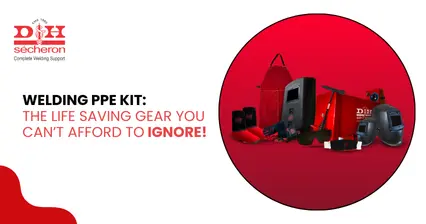What is Hardfacing?
Before we jump to the techniques and process of hardfacing welding, let us primarily understand what does hardfacing welding mean. Hardfacing welding technique is used to make equipment more efficient by minimizing oxidation and distortion, resistance from chipping and corrosion. This process is cost-efficient compared to buying completely new equipment to replace the worn-out one. How is that?
Hardfacing a machine involves putting a tougher, harder material onto the base metal to increase its lifespan. Generally, hardfacing takes the form of specialized hardfacing electrodes for MIG welding or arc welding. This is a fast and easy method that also helps reduce the number of spare parts kept in the inventory.
Significant reduction in production cost and lessened machine downtime is the key reason why the use of hardfacing machines has become popular in food, petrochemical, mining, power, cement, sugarcane and steel industries. Using the hardfacing technique can make new machines resistant and lengthen their life by up to 300%. When used on old equipment, hardfacing can return worn parts to nearly new condition at 25-75% less cost than that incurred on replacement of those parts.
What materials can be applied in the hardfacing process?
No matter the industry in which a machine is used, there is a specified hardfacing welding electrode that can be appropriately used to offer maximum resistance to wear and erosion. The common materials, however, used widely across all industries include NOREM, chromium carbide alloys, stellite or cobalt-based alloys and nickel-based alloys. Carbide or chromium carbide alloys are generally used in case of low-stress scratching on machines. Here the wear is very minimal and can be caused by scouring actions of materials around the equipment. In case if you wish to add your band name or additional information or need to add color to refine the work, hot stamping can be used post hardfacing. Most commercial industries make use of films or foils to add an additional layer of protection and/or to give the machine a metallic effect.
What steps one should follow before hardfacing a machine?
Yes, the problem at hand is a worn-out machine and the immediately required step is to get it hardfaced. But before you do that, make sure you follow these steps:
Clean the machine and especially the parts to be hardfaced very well
Wipe it free of all contaminants such as grease, dirt, oil, or rust.
If necessary, remove the old hardfacing layers and/or cracks by using the arc or plasma gouging technique.
The size, shape and location of the equipment or its parts will determine the welding technique to be used while hardfacing. So make sure you keep that in mind.
Hardfacing most commonly makes use of the stick welding (SMAW) process as it is highly portable or the flux-cored (FCAW) welding technique. For welding large and thicker parts on regular basis, companies also make use of the submerged arc welding (SAW) process.
With this, your machine is prepped to be hardfaced and become more efficient.
Conclusion:
Hardfacing is a valuable technique that can help save your expenditure and time too. If you wish to know more about welding and everything around it, we are here to help you. The world of welding can be a little complicated but taking your time to learn the processes goes a long way.
11 May 2025 | Welding
An In-Depth Exploration of Low-Alloy Steel: Your Comprehensive Guide
11 May 2025 | Welding
Nagpur - Bori - Tuljapur Road MSH-3 in Yavatmal District (Maharashtra)
11 May 2025 | Welding
Guidelines to Understand Gas Welding: Applications, Advantages & Disadvantages
11 May 2025 | Welding
3 Tips for Finding the Best Mild Steel Electrode for Your Application
11 May 2025 | Welding
How to Select the Right Welding Filler Wires for Stainless Steel Welding?
11 May 2025 | Welding
Building the Narendra Modi Stadium with Norma V and Autotherme-1 Electrodes
11 May 2025 | Welding
Low Alloy Steel Welding in a (PEB) Pre Engineered Building Structure
11 May 2025 | Welding
Welding Rods: Different Types and Tips for Properly Storing and Handling
11 May 2025 | Welding
Tips for Flawless Welds with Stainless Steel Electrodes: Pros and Cons
11 May 2025 | Welding
Exploring Applications and Benefits of Stainless Steel Welding Electrodes
11 May 2025 | Welding
Welding Basics: Joining Metals with Heat and Pressure - A Beginners Guide
11 May 2025 | Welding
Distinguishing Low-Alloy Steel from High-Alloy Steel: Understanding the Variations
11 May 2025 | Welding
Hard Facing Wire - Understanding the Process and Achieving Optimal Result
11 May 2025 | Welding
Exploring the Advantages of Stainless Steel Electrodes in Welding Applications
11 May 2025 | Welding
Weathering Steel vs. Traditional Steel: A Comparative Analysis of Performance
11 May 2025 | Welding
Choosing the Right Welding Rod: Why 6013 Electrodes Might Be Your Ideal Option
11 May 2025 | Welding
Why 7018 Electrodes Are Preferred for High-Strength Welds in Pipeline Construction
11 May 2025 | Welding
Filler Wire vs. Stainless Steel Filler Wire: Understanding the Key Differences
11 May 2025 | Welding
Exploring the Impact of Filler Material on Welding Quality and Durability
11 May 2025 | Welding
Choosing the Right Cast Iron Electrode for Different Welding Projects
11 May 2025 | Welding
Top Advantages of Cast Iron Electrodes for Industrial Welding Applications
11 May 2025 | Welding
Key Benefits and Challenges of Using TIG Welding in Industrial Projects
11 May 2025 | Welding
5 Reasons Why 7018 Electrode is the Gold Standard for Welding Professionals
11 May 2025 | Welding
Top 5 Advantages of Flux Cored Arc Welding for Heavy-Duty Applications.png)
11 May 2025 | Welding
Lotherme-601: A Game-Changer for Restoring Shoulder Pins in Heavy Machinery
11 May 2025 | Welding
How D&H Sécheron Helped Repair a Rotary Kiln’s Cooler Section with LoTherme 352
11 May 2025 | Welding
Piston Repair for Mining Industry: Cost-Effective Solutions with LoTherme 468.webp)






.jpg)







































.jpg)
.jpg)

.jpg)

.jpg)





.jpg)
.jpg)
.jpg)



.webp)
.jpg)
.jpg)
.webp)
.jpg)






















.png)



.webp)

.webp)
.webp)



